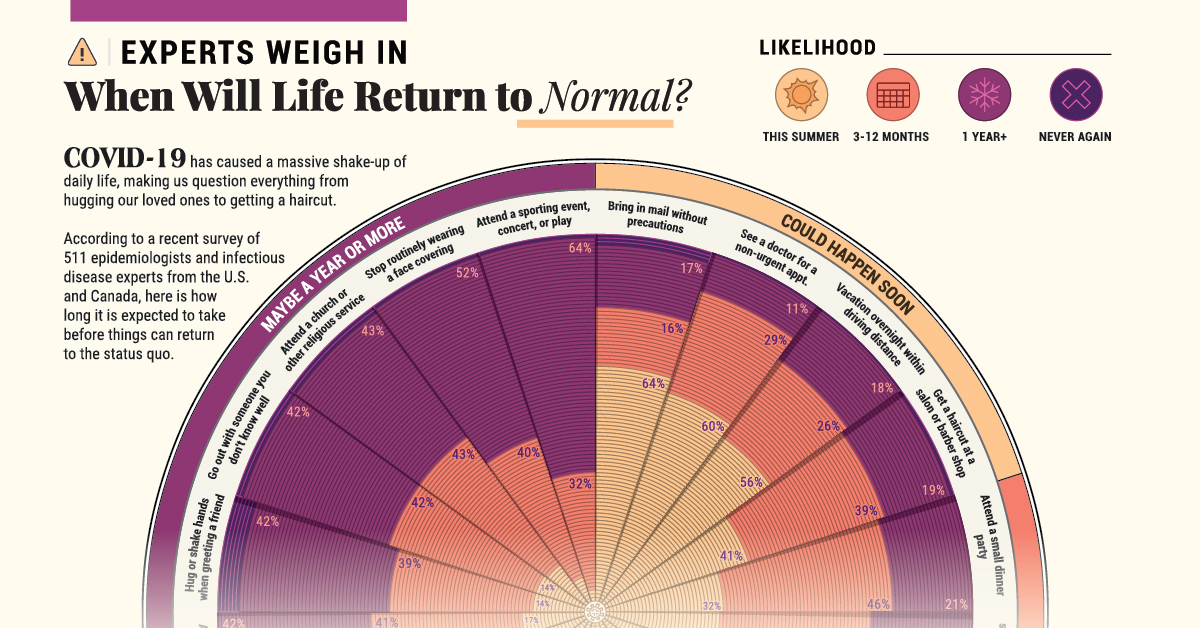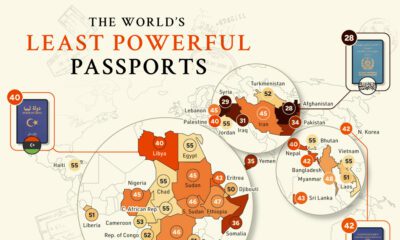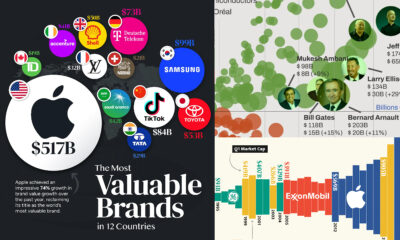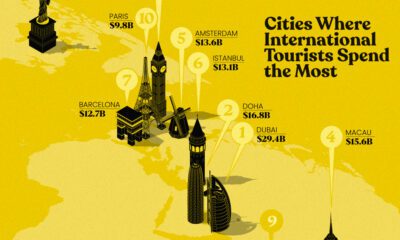Misc
When Will Life Return to Normal?
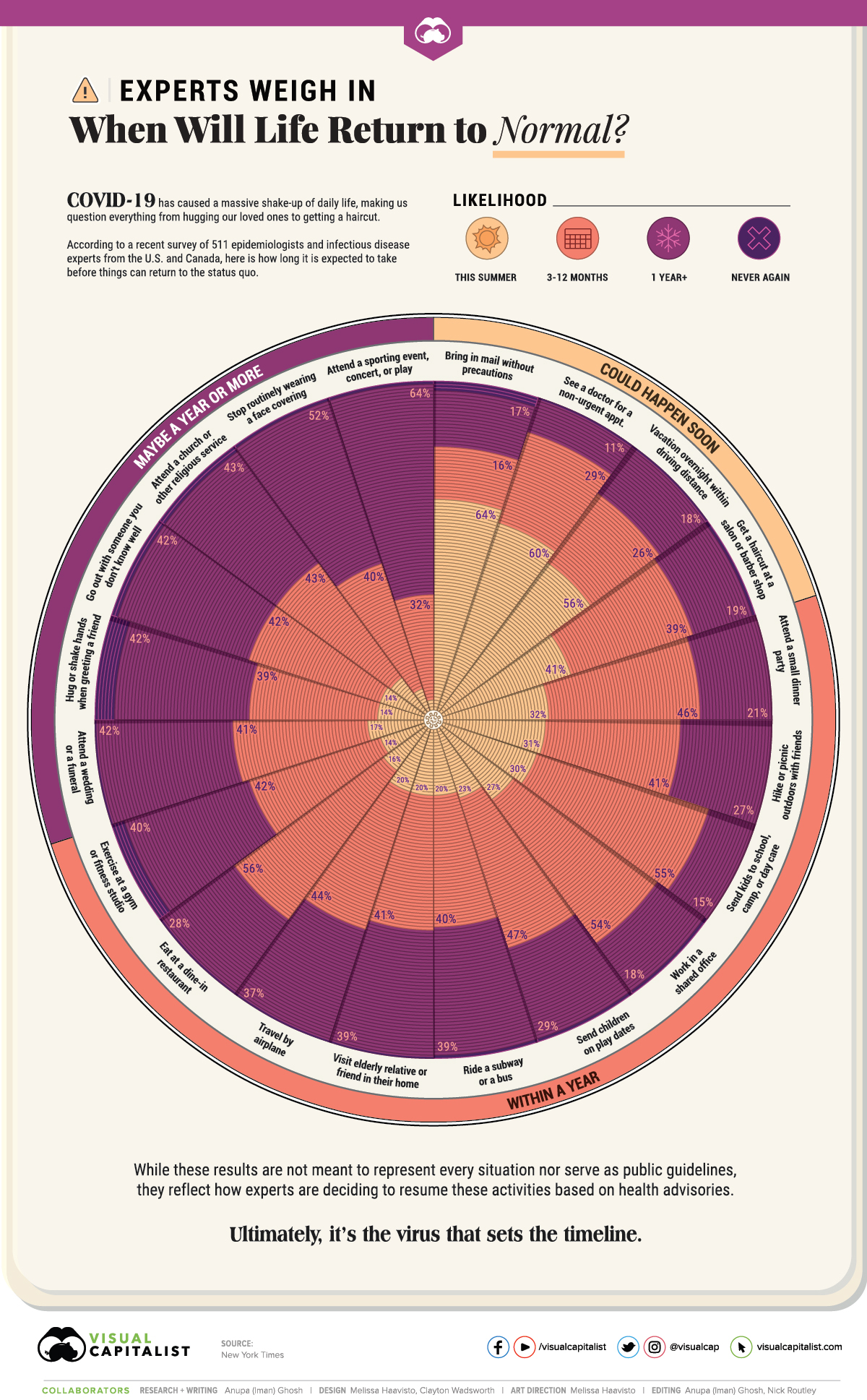
When Will Life Return to Normal?
From battles on the front lines to social distancing from friends and family, COVID-19 has caused a massive shake-up of our daily lives.
After second-guessing everything from hugging our loved ones to delaying travel, there is one big question that everyone is likely thinking about: will we ever get back to the status quo? The answer may not be very clear-cut.
Today’s graphic uses data from New York Times’ interviews of 511 epidemiologists and infectious disease specialists from the U.S. and Canada, and visualizes their opinions on when they might expect to resume a range of typical activities.
Life in the Near Future, According to Experts
Specifically, this group of epidemiologists were asked when they might personally begin engaging in 20 common daily activities again.
The responses, based on the latest publicly available and scientifically-backed data, varied based on assumptions around local pandemic response plans. The experts also noted that their answers would change depending on potential treatments and testing rates in their local areas.
Here are the activities that a majority of professionals see starting up as soon as this summer, or within a year’s time:
| This summer | 3-12 months | +1 year | Never again | |
|---|---|---|---|---|
| 📬 Bring in mail without precautions | 64% | 16% | 17% | 3% |
| 👩⚕️ See a doctor for a non-urgent appointment | 60% | 29% | 11% | <1% |
| 🚗 Vacation overnight within driving distance | 56% | 26% | 18% | <1% |
| 💇♂️ Get a haircut at a salon or barber shop | 41% | 39% | 19% | 1% |
| 🥳 Attend a small dinner party | 32% | 46% | 21% | <1% |
| 🥾 Hike or picnic outdoors with friends | 31% | 41% | 27% | <1% |
| 🎒 Send kids to school, camp, or day care | 30% | 55% | 15% | <1% |
| 🏢 Work in a shared office | 27% | 54% | 18% | 1% |
| 👶 Send children on play dates | 23% | 47% | 29% | 1% |
| 🚌 Ride a subway or a bus | 20% | 40% | 39% | 1% |
| 👴 Visit elderly relative or friend in their home | 20% | 41% | 39% | <1% |
| ✈️ Travel by airplane | 20% | 44% | 37% | <1% |
| 🍽️ Eat at a dine-in restaurant | 16% | 56% | 28% | <1% |
| 🏋️ Exercise at a gym or fitness studio | 14% | 42% | 40% | 4% |
The urge to be outdoors is pretty clear, with 56% of those surveyed hoping to take a road trip before the summer is over. Meanwhile, 31% felt that they would be able to go hiking or have a picnic with friends this summer, citing the need for “fresh air, sun, socialization and a healthy activity” to help keep on top of their physical and mental health during this time.
Public transport and travel of any form is one aspect that has been put on hold, whether it’s by plane, train, or automobile. Many of the surveyed epidemiologists also lamented the strain the pandemic has had on relationships, as evidenced by the social situations they hope to restart sooner rather than later.
The worst casualty of the epidemic is the loss of human contact.
—Eduardo Franco, McGill University
On the other hand, there are certain activities that they considered too risky to engage in for the time-being. A large share are putting off attending celebrations such as weddings or concerts for at least a year or more, out of perceived social responsibility.
| This summer | 3-12 months | +1 year | Never again | |
|---|---|---|---|---|
| 👰⚰️ Attend a wedding or a funeral | 17% | 41% | 42% | <1% |
| 🤗🤝 Hug or shake hands when greeting a friend | 14% | 39% | 42% | 6% |
| 💞 Go out with someone you don't know well | 14% | 42% | 42% | 2% |
| 🛐 Attend a church or other religious service | 13% | 43% | 43% | 2% |
| 😷 Stop routinely wearing a face covering | 7% | 40% | 52% | 1% |
| 🎫 Attend a sporting event, concert, or play | 3% | 32% | 64% | 1% |
Perhaps the most surprising finding is that 6% of epidemiologists do not expect to ever hug or shake hands as a post-pandemic greeting. On top of this, over half consider masks necessary for at least the next year.
The Virus Sets the Timeline
Of course, these estimates are not meant to represent every situation. The experts also practically considered whether certain activities were avoidable or not—such as one’s occupation—which affects individual risk levels.
The answers [about resuming these activities] have nothing to do with calendar time.
—Kristi McClamroch, University at Albany
While many places are trickling out of lockdown and re-opening to support the economy, some officials are still warning against prematurely lifting restrictions before we fully have a handle on the virus and its spread.
Misc
How Hard Is It to Get Into an Ivy League School?
We detail the admission rates and average annual cost for Ivy League schools, as well as the median SAT scores required to be accepted.

How Hard Is It to Get Into an Ivy League School?
This was originally posted on our Voronoi app. Download the app for free on iOS or Android and discover incredible data-driven charts from a variety of trusted sources.
Ivy League institutions are renowned worldwide for their academic excellence and long-standing traditions. But how hard is it to get into one of the top universities in the U.S.?
In this graphic, we detail the admission rates and average annual cost for Ivy League schools, as well as the median SAT scores required to be accepted. The data comes from the National Center for Education Statistics and was compiled by 24/7 Wall St.
Note that “average annual cost” represents the net price a student pays after subtracting the average value of grants and/or scholarships received.
Harvard is the Most Selective
The SAT is a standardized test commonly used for college admissions in the United States. It’s taken by high school juniors and seniors to assess their readiness for college-level academic work.
When comparing SAT scores, Harvard and Dartmouth are among the most challenging universities to gain admission to. The median SAT scores for their students are 760 for reading and writing and 790 for math. Still, Harvard has half the admission rate (3.2%) compared to Dartmouth (6.4%).
| School | Admission rate (%) | SAT Score: Reading & Writing | SAT Score: Math | Avg Annual Cost* |
|---|---|---|---|---|
| Harvard University | 3.2 | 760 | 790 | $13,259 |
| Columbia University | 3.9 | 750 | 780 | $12,836 |
| Yale University | 4.6 | 760 | 780 | $16,341 |
| Brown University | 5.1 | 760 | 780 | $26,308 |
| Princeton University | 5.7 | 760 | 780 | $11,080 |
| Dartmouth College | 6.4 | 760 | 790 | $33,023 |
| University of Pennsylvania | 6.5 | 750 | 790 | $14,851 |
| Cornell University | 7.5 | 750 | 780 | $29,011 |
*Costs after receiving federal financial aid.
Additionally, Dartmouth has the highest average annual cost at $33,000. Princeton has the lowest at $11,100.
While student debt has surged in the United States in recent years, hitting $1.73 trillion in 2023, the worth of obtaining a degree from any of the schools listed surpasses mere academics. This is evidenced by the substantial incomes earned by former students.
Harvard grads, for example, have the highest average starting salary in the country, at $91,700.
-

 Mining2 weeks ago
Mining2 weeks agoCharted: The Value Gap Between the Gold Price and Gold Miners
-

 Real Estate1 week ago
Real Estate1 week agoRanked: The Most Valuable Housing Markets in America
-

 Business1 week ago
Business1 week agoCharted: Big Four Market Share by S&P 500 Audits
-

 AI1 week ago
AI1 week agoThe Stock Performance of U.S. Chipmakers So Far in 2024
-

 Misc1 week ago
Misc1 week agoAlmost Every EV Stock is Down After Q1 2024
-

 Money2 weeks ago
Money2 weeks agoWhere Does One U.S. Tax Dollar Go?
-

 Green2 weeks ago
Green2 weeks agoRanked: Top Countries by Total Forest Loss Since 2001
-

 Real Estate2 weeks ago
Real Estate2 weeks agoVisualizing America’s Shortage of Affordable Homes




